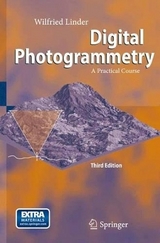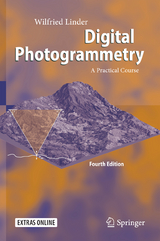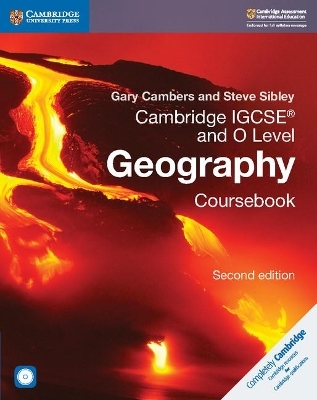Digital Photogrammetry
A Practical Course
Seiten
2009
|
3rd ed. 2009
Springer Berlin
978-3-540-92724-2 (ISBN)
Springer Berlin
978-3-540-92724-2 (ISBN)
- Titel erscheint in neuer Auflage
- Artikel merken
Zu diesem Artikel existiert eine Nachauflage
With several tutorials of increasing complexity, accompanied by texts explaining further theory, this third edition is an "all-in-one" combination of basic theory and practical exercises on digital photogrammetry.
1.1 Basic idea and main task of photogrammetry If you want to measure the size of an object, let's say the length, width and height of a house, then normally you will carry this out directly at the object. Now imagine that the house didn't exist anymore - it was destroyed, but some historic photos exist. Then, if you can determine the scale of the photos, it must be pos- ble to get the desired data. Of course you can use photos to get information about objects. This kind of - formation is different: So, for example, you may receive qualitative data (the house seems to be old, the walls are coloured light yellow) from photo interpre- tion, or quantitative data like mentioned before (the house has a base size of 8 by 6 meters) from photo measurement, or information in addition to your background knowledge (the house has elements of the "art nouveau" style, so may be c- th structed at the beginning of the 20 century), and so on.
1.1 Basic idea and main task of photogrammetry If you want to measure the size of an object, let's say the length, width and height of a house, then normally you will carry this out directly at the object. Now imagine that the house didn't exist anymore - it was destroyed, but some historic photos exist. Then, if you can determine the scale of the photos, it must be pos- ble to get the desired data. Of course you can use photos to get information about objects. This kind of - formation is different: So, for example, you may receive qualitative data (the house seems to be old, the walls are coloured light yellow) from photo interpre- tion, or quantitative data like mentioned before (the house has a base size of 8 by 6 meters) from photo measurement, or information in addition to your background knowledge (the house has elements of the "art nouveau" style, so may be c- th structed at the beginning of the 20 century), and so on.
Wilfried Linder, born in 1959, studied mathematics and geography at the University of Hannover (1979-85). Thereafter, he was employed as a scientific assistant at the Universities of Osnabrück/Vechta, Hannover and Düsseldorf. In 1990 he received his Ph.D in geography, followed in 1993 by one in geodesy. He is now a member of the Institute of Geography at the University of Düsseldorf, where he is responsible for the fields of photogrammetry, remote sensing, digital cartography and geo information systems (GIS).
Included software and data.- Scanning of photos.- Example 1: A single model.- Example 2: Aerial triangulation.- Example 3: Some special cases.- Programme description.
| Zusatzinfo | XV, 220 p. With 3-D glasses. With CD-ROM. |
|---|---|
| Verlagsort | Berlin |
| Sprache | englisch |
| Maße | 155 x 235 mm |
| Gewicht | 510 g |
| Themenwelt | Naturwissenschaften ► Geowissenschaften ► Geografie / Kartografie |
| Schlagworte | Cartography • Geodesy • Geography • Geoinformation • Landscape Planning • Remote Sensing |
| ISBN-10 | 3-540-92724-7 / 3540927247 |
| ISBN-13 | 978-3-540-92724-2 / 9783540927242 |
| Zustand | Neuware |
| Informationen gemäß Produktsicherheitsverordnung (GPSR) | |
| Haben Sie eine Frage zum Produkt? |
Mehr entdecken
aus dem Bereich
aus dem Bereich
Wasserstraßen zwischen Emmerich, Hörstel und Mainz
Media-Kombination (2023)
Kartenwerft
49,90 €
Media-Kombination (2018)
Cambridge University Press
41,50 €




